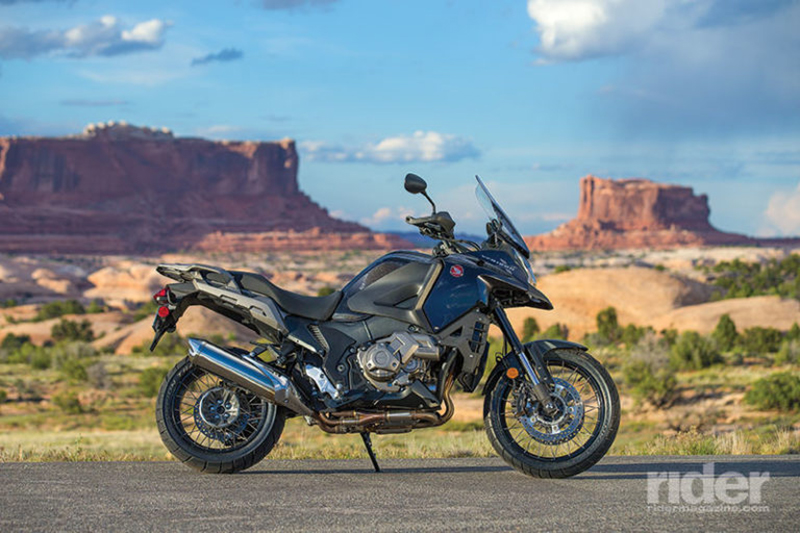2016 Honda VFR1200X

Road Test Review
Shortly after its groundbreaking VFR1200F sport tourer was introduced for 2010, Honda launched an adventure-styled bike for 2012 based on the same smooth and powerful 1,237cc V-4 engine used in the VFR. The new Crosstourer was designed to compete with the BMW R 1200 GS, Yamaha Super Ténéré and Triumph Tiger Explorer, so it had 19- and 17-inch spoked tubeless wheels, enduro-like upright seating, increased suspension travel and—key in this displacement class—shaft final drive. The big adventure bike market was heating up and the competition was starting to invade what had been exclusively BMW’s turf, so the time was right for the Crosstourer. Except that in late 2011, one dollar only bought about 77 yen, which meant that the bike would be too pricey for the American market. So while the Europeans went Crosstouring, we waited—a pity because in many respects it was a better fit for us Yanks than the VFR1200F, which Honda has since dropped from its lineup.
In the meantime, Combined ABS was added to the Crosstourer in 2013, and the 2014 model received a new seat for improved comfort and an easier reach to the ground, self-canceling turn signals, Honda Selectable Torque Control (HSTC, or traction control) and software refinements to the optional Dual Clutch Transmission (DCT) to give the automatic shifting system a more natural feel, both on the highway and on back roads.
With the dollar strong again and the ADV market redlining, Honda has finally brought us the Crosstourer for 2016, rebadged simply VFR1200X for the U.S. While the new Africa Twin handles the real dirty side of Honda’s ADV salvo, the VFR1200X serves up some serious sport-touring performance and comfort, with just enough adventure in its blood to tackle a little dirt. For 2016, the bike gets a one-hand adjustable windscreen, a 12V socket up front with an optional one available for the rear, and three levels for the Sport mode in the optional DCT. Weighing a claimed 608 pounds ready to ride with 5.7 gallons of fuel (631 pounds for the DCT model), it’s certainly no dirt bike, but the VFR-X’s Pirelli Scorpion Trail tubeless tires, spoked wheels, 5.7 inches of suspension travel front and rear and good ground clearance help it get down graded dirt or gravel roads at a decent pace. The bike is really intended for the pavement, though, and after putting more than 1,600 miles on one at the intro in Moab, Utah, and on a circuitous ride back to California, I can confirm that—if you can deal with a seat height of 33.5 inches, or 32.5 for the optional low seat—it’s a terrific sport-touring machine with a useful touch of off-road ability.
Much of that is due to the competence of the V-4 engine, which has been retuned from VFR1200F spec to dish out more low- and midrange torque. Its split personality makes it a perfect fit, as it’s capable of lugging down to 2,000 rpm and chugging through the mud, or eliciting a soulful wail and rocketing the bike down the highway, even two-up and fully loaded. On the Jett Tuning dyno, we found torque output is up significantly in the 2,000-5,500 rpm range over the VFR1200F, then runs about even at 80 lb-ft until dropping off just before the X’s lower redline of about 8,800 rpm. Peak horsepower of 108 is way down from the VFR-F’s 150 at the rear wheel, but that was achieved at sportbike engine speeds that most X riders won’t need or use.
The X’s liquid-cooled, 1,237cc mill is a narrow 76 degrees between the front and rear cylinders, with a phase-shift crankshaft to eliminate primary vibration and the need for a counterbalancer. The two rear cylinders are closer together than the two fronts to centralize mass and narrow the engine directly under the rider. Unicam cylinder heads, which have a single overhead cam that actuates the intake valves and roller rocker arms to actuate the exhausts, help shorten the V-4 as well. The X’s engine is lighter and more compact than the 782cc Interceptor engine, in fact, no small feat with a 455cc gain in displacement.
Throttle-by-wire enables more precise power control and allows the HSTC traction control to modulate the throttle butterflies, along with cutting the ignition to control wheel spin according to the TC’s set intervention level (1, 2, 3 or off). Instead of wires, the VFR1200X has regular cables running from the throttle to the TBW servo to eliminate a “disconnected” feel, and it works well.
Just like the VFR1200F, the VFR1200X is available in two versions, one with a conventional manual 6-speed transmission, the other with Honda’s automatic Dual Clutch Transmission for an extra $400. The VFR1200F’s 6-speed DCT was a first for motorcycles when it was introduced in 2010, and the X gets the third generation with numerous refinements. It offers Drive, Sport and Manual modes, with a paddle shifter on the left bar and no clutch lever. Diehards can get a foot shift lever as an accessory. The latest DCT version adds three levels of automatic operation to Sport mode, each one holding a gear a little longer than the last before it upshifts, and downshifting sooner.
For a sport-touring rider, DCT adds convenience and is a worthwhile addition to the VFR1200X. Start the bike, press a button to put it into Drive or Sport, twist the throttle and you’re off. Drive mode could justifiably be called Economy mode, as the DCT upshifts through the gears very quickly, hitting sixth at as little as 31 mph depending upon how hard you’re accelerating. Although it feels as if the engine is lugging at first, you quickly get used to the twin-cylinder-like resonance of the engine at lower rpm. Twisting the throttle hard will kick the DCT down a gear or two for passing, and you can override the system’s gear selection with the paddle shifter at any time. I spent far more time in Drive than in Sport mode, which doesn’t select sixth gear until 71 mph and tends to hold lower gears far longer for brisk acceleration. Of its three new modes I found the default, or S3, plenty playful, and just overrode it to upshift into a higher gear as needed. Selecting Manual mode makes the DCT work just like a standard 6-speed transmission, except that it will downshift into first at stops and there’s no clutch lever. The whole DCT process is much smoother and quieter than it was on the original VFR1200F DCT. We also got a spin on a VFR1200X with a manual transmission, and found that it shifted smoothly, with good feel at the clutch lever.
Power goes rearward via shaft final drive in the Pro-Arm single-sided swingarm, the yoke-shaped front of which encircles the linked rear shock and pivots on the all-aluminum twin-spar frame. The bike’s chassis rigidity and firm suspension give it a solid, stable feel on the highway and in corners, even at higher speeds with a load, and the suspension offers spring preload and rebound damping adjustability front and rear, with a remote adjuster for the rear preload. It’s firm enough that the washboard surface in places on Utah’s Montezuma Canyon dirt road caused some chatter, the cure for which was simply slowing down. Cornering clearance is ample for spirited riding on winding roads, and the street-biased Scorpion Trail tires stick well and roll nicely through the corners. The rubber was also very confidence inspiring on dirt roads as long as they were hard-packed, but with a full load in the luggage the bike had a tendency to weave a bit in loose sand or gravel. Linking the triple disc brakes rear-to-front helps the VFR-X stop exceptionally hard on the pavement, there’s good feel at the lever and pedal and the ABS prevents lockups on the street or in the dirt. It can’t be switched off without pulling a fuse, but I never felt the need to do so.
On the long ride home from Moab, which included the Moki Dugway, State Routes 95, 24 and 12 in Utah and a slog on Interstate 15 from St. George to California, the VFR1200X was a comfortable companion. The seat is firm and supportive, the grips set at a natural height and width (some may find them a little forward, but that’s easily remedied) and the footpegs are low and forward, a good position when your feet are on them, though they can get in the way at stops and it’s hard to stand up on them without hitting the tank with your knees. Wind protection is top notch from the stock hand guards and wide fairing lowers, which were extended on our test bike with optional wind deflectors. Up top, the adjustable windscreen does a better job than you would think for its size, quieting the windblast to near zero in the up position, and it’s easily raised and lowered about 4 inches with a clever one-handed lever on the left. Except for being on tiptoes at stops, overall I found the VFR1200X as comfortable and smooth for long rides as many larger touring and sport-touring bikes, and I took a short ride on the passenger pillion and found it plush, roomy and secure, with good grab handles.
Although bells and whistles like electronically adjustable suspension, riding modes, cruise control, an adjustable seat and such are nowhere to be found despite the VFR1200X’s premium price, it is still nicely equipped with adjustable brake and clutch levers, an accessory outlet, LED turn signals and taillight, and a useful LCD display with gear indicator, fuel gauge and basic trip computer with reserve range countdown. Our test bike was also equipped with nearly every accessory in the bike’s catalog (see specs), including good heated grips and the very pricey but functional hard luggage, which is made of lightweight plastic with a brushed aluminum finish. The X comes with integrated mounts for the panniers, which help keep them narrow at just 36 inches across the back despite their generous size. They mount easily and the 39-liter left one will hold a full-face helmet (the 36-liter right is indented to clear the muffler). The cost of that integration is dear, though, at $1,440 for the panniers and $760 for the 39-liter top case.
For many riders the VFR1200X’s character-filled V-4 will be all it takes to sway them, getting all the satisfaction they need and more from the ripping-velvet growl that emanates from one of Honda’s most venerated engine layouts. Others will look at the X’s price and wonder why they should pay the same or more than the competition for fewer standard features. We’ll see if the VFR1200X was worth the wait in an upcoming comparo.
